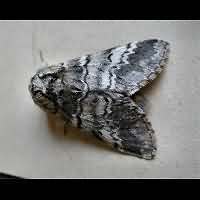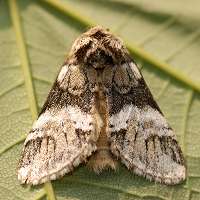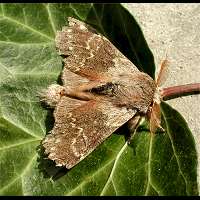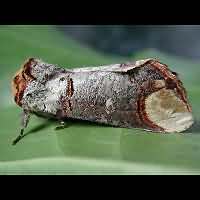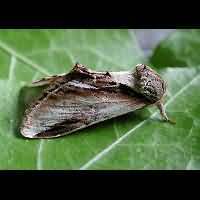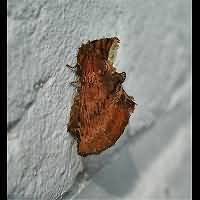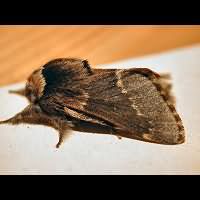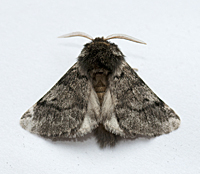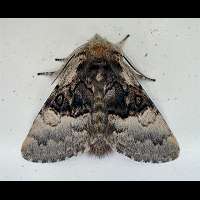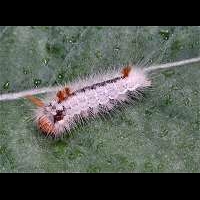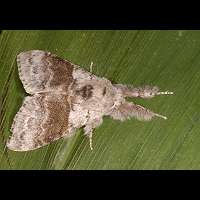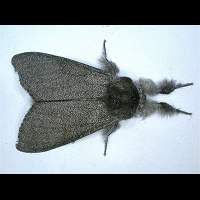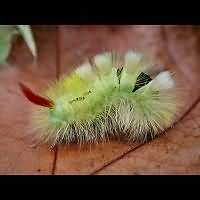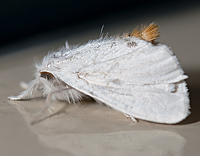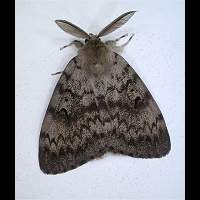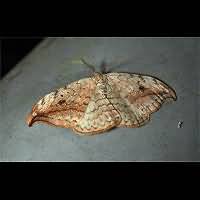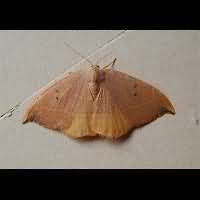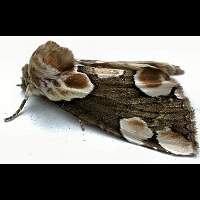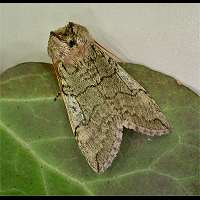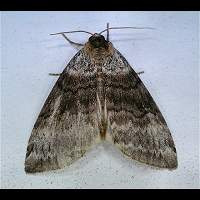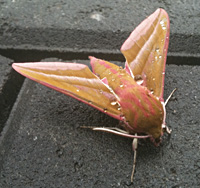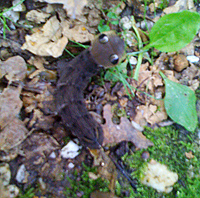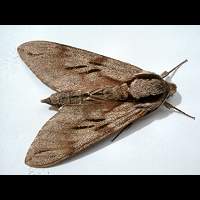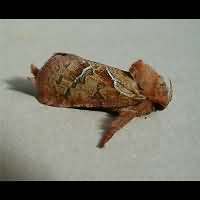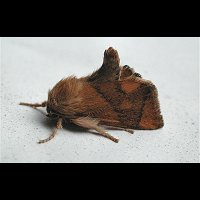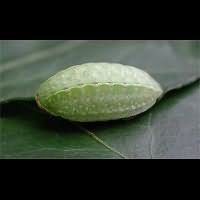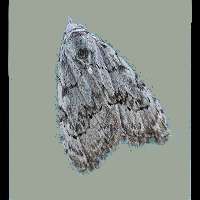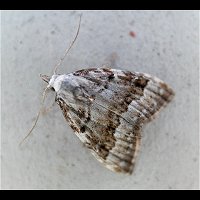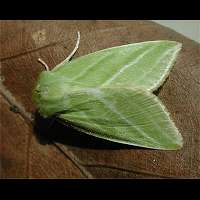[All pictures of garden wildlife on this page are thumbnails. Click on any thumbnail for a large format to be displayed.]
This is a collection of Macro Moths, not delt with before. Usually this is due to the fact that they belong to smaller families, or to families of which only a few species are regularly seen in gardens. Most of these moths look a lot like Noctuids, such as the Pantheids, Eggars, some Tuft Moths and adult Slug Moths. Most Hawk-moths do look very different, but so far only a few have visited our garden. Of the very big moths in our region, most belong to the Hawk moths, of which some species will reach a wing span of some 140 mm! Among the Hook-tips are some that look like Noctuids, while other are similar to Geometer Worms. Some information about the family characteristics is given in the decription of the first representative of each family below. Just click on More... in the text on the right of the picture.
Lunar Marbled Brown (Drymonia ruficornis)
The Lunar Marbled Brown is an unmistakable, but very Noctuid like species. more...
Family: Prominents (Notodontidae)
The Lunar Marbled Brown is an unmistakable, but very Noctuid like species. more...
Family: Prominents (Notodontidae)
Marbled Brown (Drymonia dodonaea)
The Marbled Brown is not unlike the previous species, but more brownish and less greyish. more...
Family: Prominents (Notodontidae)
The Marbled Brown is not unlike the previous species, but more brownish and less greyish. more...
Family: Prominents (Notodontidae)
Lobster Moth (Stauropus fagi)
The English common name of Lobster Moth refers to the caterpillar and not to the adult moth. more...
Family: Prominents (Notodontidae)
The English common name of Lobster Moth refers to the caterpillar and not to the adult moth. more...
Family: Prominents (Notodontidae)
Buff-tip (Phalera bucephala)
Identifying the Buff-tip is extremely easy: there is simply not one other moth like it. more...
Family: Prominents (Notodontidae)
Identifying the Buff-tip is extremely easy: there is simply not one other moth like it. more...
Family: Prominents (Notodontidae)
Lesser Swallow Prominent (Pheosia gnoma)
Usually the markings in the Lesser Swallow Prominent are clearer than in the similar Swallow Prominent, which may be a bit larger. more...
Family: Prominents (Notodontidae)
Usually the markings in the Lesser Swallow Prominent are clearer than in the similar Swallow Prominent, which may be a bit larger. more...
Family: Prominents (Notodontidae)
Coxcomb Prominent (Ptilodon capucina)
The Coxcomb Prominent is another unmistakable moth. more...
Family: Prominents (Notodontidae)
The Coxcomb Prominent is another unmistakable moth. more...
Family: Prominents (Notodontidae)
December Moth (Poecilocampa populi)
Dark, hairy moth, often not on the wing untill after the first night frost. That also explains why it is called the December Moth, even though it may be flying about a month earlier. more...
Family: Eggars (Lasiocampidae)
Dark, hairy moth, often not on the wing untill after the first night frost. That also explains why it is called the December Moth, even though it may be flying about a month earlier. more...
Family: Eggars (Lasiocampidae)
Oak Processionary Moth (Thaumetopoea processionea)
This moth is native to central and southern Europe. Both the English and scientific names refer to the peculiar behaviour of the larvae of forming a long nose-to-tail procession. more...
Family: Thaumetopoeidae
This moth is native to central and southern Europe. Both the English and scientific names refer to the peculiar behaviour of the larvae of forming a long nose-to-tail procession. more...
Family: Thaumetopoeidae
Nut-tree Tussock (Colocasia coryli)
The adult Nut-tree Tussock does look like an Owlet Moth very much. more...
Family: Pantheids (Pantheidae)
The adult Nut-tree Tussock does look like an Owlet Moth very much. more...
Family: Pantheids (Pantheidae)
Nut-tree Tussock (Colocasia coryli)
The caterpillar of the Nut-tree Tussock however looks like a Tussock's, even though they are not really closely related to one another. more...
Family: Pantheids (Pantheidae)
The caterpillar of the Nut-tree Tussock however looks like a Tussock's, even though they are not really closely related to one another. more...
Family: Pantheids (Pantheidae)
Pale Tussock Moth (Calliteara pudibunda)
The pale and well marked version of the Pale Tussock Moth. more...
Family: Tussock Moths (Lymantriidae)
The pale and well marked version of the Pale Tussock Moth. more...
Family: Tussock Moths (Lymantriidae)
Pale Tussock Moth (Calliteara pudibunda)
The dark form of the Pale Tussock Moth is much more difficult to identify. more...
Family: Tussock Moths (Lymantriidae)
The dark form of the Pale Tussock Moth is much more difficult to identify. more...
Family: Tussock Moths (Lymantriidae)
Pale Tussock Moth (Calliteara pudibunda)
The caterpillar of the Pale Tussock Moth is one of the most beautiful in our parts of the world. more...
Family: Tussock Moths (Lymantriidae)
The caterpillar of the Pale Tussock Moth is one of the most beautiful in our parts of the world. more...
Family: Tussock Moths (Lymantriidae)
Yellow-tail (Euproctis similis)
The male of the Yellow-tail has the black dot as seen in the picture, the female is similar, but entirely white. more...
Family: Tussock Moths (Lymantriidae)
The male of the Yellow-tail has the black dot as seen in the picture, the female is similar, but entirely white. more...
Family: Tussock Moths (Lymantriidae)
Yellow-tail (Euproctis similis)
During daytime the caterpillar of the Yellow-tail is often seen sitting on top of plants or leaves. more...
Family: Tussock Moths (Lymantriidae)
During daytime the caterpillar of the Yellow-tail is often seen sitting on top of plants or leaves. more...
Family: Tussock Moths (Lymantriidae)
Black Arches (Lymantria monacha)
Black Arches also comes in a finely marked version, but in our garden we only had this dark, nondescript edition. more...
Family: Tussock Moths (Lymantriidae)
Black Arches also comes in a finely marked version, but in our garden we only had this dark, nondescript edition. more...
Family: Tussock Moths (Lymantriidae)
Gypsy Moth (Lymantria dispar)
This is a male of the Gypsy Moth. The female is white with small indented black lines. more...
Family: Tussock Moths (Lymantriidae)
This is a male of the Gypsy Moth. The female is white with small indented black lines. more...
Family: Tussock Moths (Lymantriidae)
Pebble Hook-tip Moth (Drepana falcataria)
The Pebble Hook-tip is another unmistakable moth, clearly showing why it is called a Hook-tip. more...
Family: Hook-tip Moths (Drepanidae)
The Pebble Hook-tip is another unmistakable moth, clearly showing why it is called a Hook-tip. more...
Family: Hook-tip Moths (Drepanidae)
Oak Hook-tip (Watsonella binaria)
The Oak Hook-tip is a colourful moth, on the wing in daylight, but rarely seen in gardens. more...
Family: Hook-tip Moths (Drepanidae)
The Oak Hook-tip is a colourful moth, on the wing in daylight, but rarely seen in gardens. more...
Family: Hook-tip Moths (Drepanidae)
Peach Blossom (Thyatira batis)
The Peach Blossom is a beautiful moth, especially when fresh, and unmistakable. more...
Family: Hook-tip Moths (Drepanidae)
The Peach Blossom is a beautiful moth, especially when fresh, and unmistakable. more...
Family: Hook-tip Moths (Drepanidae)
Yellow Horned (Achlya flavicornis)
The Yellow Horned is a Hook-tip without hooks and very similar to the Noctuids indeed. more...
Family: Hook-tip Moths (Drepanidae)
The Yellow Horned is a Hook-tip without hooks and very similar to the Noctuids indeed. more...
Family: Hook-tip Moths (Drepanidae)
Satin Lutestring (Tetheella fluctuosa)
The Satin Lutestring is a local species confined to the presence of birches. more...
Family: Hook-tip Moths (Drepanidae)
The Satin Lutestring is a local species confined to the presence of birches. more...
Family: Hook-tip Moths (Drepanidae)
Elephant Hawk-moth (Deilephila elpenor)
In beautiful watercolours of pink and green: the Elephant Hawk-moth. There is a similar but smaller species as well. more...
Family: Hawk-moths (Sphingidae)
In beautiful watercolours of pink and green: the Elephant Hawk-moth. There is a similar but smaller species as well. more...
Family: Hawk-moths (Sphingidae)
Elephant Hawk-moth (Deilephila elpenor)
The caterpillar of Deilephila elpenor is very impressive. more...
Family: Hawk-moths (Sphingidae)
The caterpillar of Deilephila elpenor is very impressive. more...
Family: Hawk-moths (Sphingidae)
Pine Hawk-moth (Sphinx pinastri)
The Pine Hawk-moth is the dullest of them all. more...
Family: Hawk-moths (Sphingidae)
The Pine Hawk-moth is the dullest of them all. more...
Family: Hawk-moths (Sphingidae)
Orange Swift (Triodia sylvina)
The larvae of the Orange Swift live on a tough diet of roots and overwinter twice. more...
Ghost Moths, aka Swifts (Hepialidae)
The larvae of the Orange Swift live on a tough diet of roots and overwinter twice. more...
Ghost Moths, aka Swifts (Hepialidae)
Festoon (Apoda limacodes)
The Festoon usually rests holding its tail high up in the air. more...
Family: Slug Moths (Limacodidae)
The Festoon usually rests holding its tail high up in the air. more...
Family: Slug Moths (Limacodidae)
Festoon (Apoda limacodes)
Slug or caterpillar? Sometimes that's the question, especially with caterpillar of the Festoon. more...
Family: Slug Moths (Limacodidae)
Slug or caterpillar? Sometimes that's the question, especially with caterpillar of the Festoon. more...
Family: Slug Moths (Limacodidae)
The Black Arches, including the Least Black Arches, are part of a family of moths called the Tuft Moths. Scientists still disagree about this complicated family. At this moment most think that in our parts this is one family, divided into three uneven subfamilies:
1 the Black Arches (Nolinae), consisting of 5 species in Britain
2 the Nycteolines (Sarrothripinae), only reprented by two species in our parts
3 the Green Peas (Chloephorinae) of which 4 species are to be found in Britain
However the situation is very unclear, for the Black Arches are sometimes considered to be a mere subfamily of the Woolly Bears and the other two groups subfamilies of the Owlet Moths. In Skinner's for instance we do find the Tuft Moths, but they are only consisting of the Black Arches, while the other two subfamilies are dealt with in the section about Noctuids. All Tuft Moths do have one thing in common though: they have small tufts of erected scales on the forewing, hence the common name of the group. Anyway, the exact division of this group remains unclear. In our garden we have discovered two subfamilies to this very moment. We have not seen any of the Nycteolines yet. These are difficult to identify though, for whether you consider them to be Tuft Moths or Owlet Moths they rather look like Tortrixes!
1 the Black Arches (Nolinae), consisting of 5 species in Britain
2 the Nycteolines (Sarrothripinae), only reprented by two species in our parts
3 the Green Peas (Chloephorinae) of which 4 species are to be found in Britain
However the situation is very unclear, for the Black Arches are sometimes considered to be a mere subfamily of the Woolly Bears and the other two groups subfamilies of the Owlet Moths. In Skinner's for instance we do find the Tuft Moths, but they are only consisting of the Black Arches, while the other two subfamilies are dealt with in the section about Noctuids. All Tuft Moths do have one thing in common though: they have small tufts of erected scales on the forewing, hence the common name of the group. Anyway, the exact division of this group remains unclear. In our garden we have discovered two subfamilies to this very moment. We have not seen any of the Nycteolines yet. These are difficult to identify though, for whether you consider them to be Tuft Moths or Owlet Moths they rather look like Tortrixes!
Least Black Arches (Nola confusalis)
Least Black Arches is a rather unobtrusive moth, appearing in spring. more...
Family: Tuft Moths (Nolidae)
Least Black Arches is a rather unobtrusive moth, appearing in spring. more...
Family: Tuft Moths (Nolidae)
Scarce Black Arches (Nola aerugula)
Scarce Black Arches also is a rather unobtrusive moth, appearing in summer. more...
Family: Tuft Moths (Nolidae)
Scarce Black Arches also is a rather unobtrusive moth, appearing in summer. more...
Family: Tuft Moths (Nolidae)
Green Silver-lines (Pseudoips prasinana)
The Green Silver-lines is a green moth very similar to an Owlet. Luckily there are not too many green ones. more...
Family: Tuft Moths (Nolidae)
The Green Silver-lines is a green moth very similar to an Owlet. Luckily there are not too many green ones. more...
Family: Tuft Moths (Nolidae)

© Copyright 1998-2024 gardensafari.net (Hania Berdys)

 English / engels
English / engels  Dutch / nederlands
Dutch / nederlands